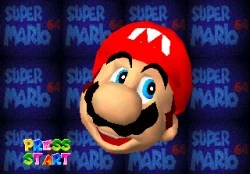Super Mario 64 is one of the two launch titles for the Nintendo 64 that took gaming to the next level. Released on September 29, 1996, crowds were charging stores to get their hands on Mario's first 3-D adventure. Many agree that this game revolutionized the platformer genre, even though it wasn't the first of its kind. Shigeru Miyamoto, the director and father of Mario, made it in such a complete and fun package that it's hard to say otherwise.
In the three-dimensional world, players were free to go wherever they liked. No longer were players restricted to go from left to right. Some people walked outside the mansion for hours just because it was just so fun to run and hop around as that little Italian.
Once you've entered the castle, your age-old nemesis, Bowser greets you with an ominous laugh. Again, Princess Peach has been kidnapped, only you don't exactly go from point A to B now. Mario must collect stars scattered in the various worlds to enter more castle rooms and ultimately enter Bowser's domain.
An altered port which came with minigames, some graphical upgrades, and even more stars came out in 2004 for the Nintendo DS under the title Super Mario 64 DS.

Players can play around with Mario's face on the title screen.
Gameplay

Mario while fighting Bowser in the Dark World.
Mario has a huge selection of moves to his disposal. He can kick and stomp now, but he can also perform huge jumps. One must master all the moves to be able to enter specific areas. Mario can also fly, turn into metal and turn invisible by unlocking special stages.
The game is divided into fifteen major levels and a few minor (secret) levels. The main goal of a mission is to find a Power Star. Once the player has enough stars, another door to a level is unlocked. There are 120 stars to collect for a 100% rating.
Courses
Super Mario 64 is divided into 15 major courses. Each course has 6 "episodes", a power star in each one. If Mario collects 100 coins in a course, he will receive another star.
- Bob-omb Battlefield
- Whomp's Fortress
- Jolly Roger Bay
- Cool, Cool Mountain
- Big Boo's Haunt
- Hazy Maze Cave
- Lethal Lava Land
- Shifting Sand Land
- Dire, Dire Docks
- Snowman's Land
- Wet-Dry World
- Tall, Tall Mountain
- Tiny-Huge Island
- Tick Tock Clock
- Rainbow Ride
Contributions to the gaming industry
One of the reasons Mario 64 is considered a major moment in Video Game history is because of how it effected the rest of the industry. Most 3D platformers from that point on took inspiration from Mario 64 as opposed to Crash Bandicoot. It did what most 3D games had problems with, and some still struggle with today, by having a camera that wasn't completely unwieldy. By using the C-buttons to adjust the camera in a direction, or the Z-stick to snap behind Mario for a playable view, players were able to adjust their range of sight to fit any situation.
Additionally, the whole idea of "item collection" or fetch quests started in this game, even though it's not significantly guilty of having this. While in the days of 2D side scrollers, where the objective is to just make it to the end of the level, 3D games provided a problem by having...well, three dimensions. Instead of the end of a level, Mario is given objectives that signify an "end", marked by the stars. Most 3D platformers after this followed this item collection format afterwards.
Items
Wing cap
Lets Mario soar through the air whilst the effect lasts. Flight is activated either by triple jumping or shooting out of a cannon.
Vanish cap
Turns Mario invisible, making him immune to some attacks and allowing him to pass through some surfaces, such as iron meshes.
Metal cap
Makes Mario invincible and allows him to walk underwater and through poison gas.
Koopa Shell
Allows Mario to ride on top of a Koopa's shell, knocking out enemies and allowing safe travel over various hazards (such as lava and quicksand).
Trivia
- The development of Super Mario 64 took less than two years, but producer/director Shigeru Miyamoto had conceived of a 3D Mario game over five years before, while working on Star Fox. Miyamoto developed most of the concepts during the era of the SNES and considered making it an SNES game (making use of the Super FX chip), but decided to develop it for the Nintendo 64 due to the earlier system's controller didn't have enough buttons.
- There was originally 32 courses planned to be in the game, however, only 15 made the final cut. Whether or not some of the "secret" courses were sections of the absent courses is unknown.
Gallery
External Links
- Coverage
- The Making of Super Mario 64 by Andy Robinson
- Super Mario 64 at the Internet Movie Database
- Super Mario 64 at StrategyWiki
- Interviews
- Videos
- Speed runs at Speed Demos Archive - 16 star, 70 star, and 120 star videos.
- Super Mario 64 N64 in 15:24 by Rikku
- Completing Super Mario 64 in 20 minutes
- Super Mario 64 Beta Sample
- Glitches
- Other
- Super Mario Wiki
- Z64 Station's Super Mario 64 Page - Contains many pictures, scans and movies.


